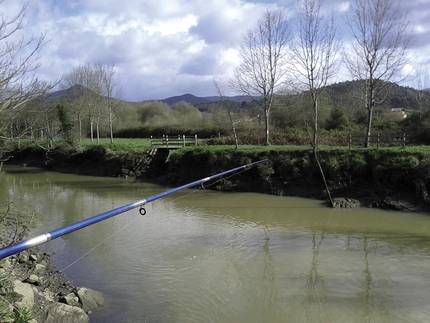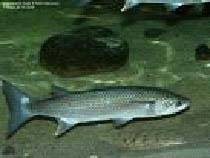Fish feminized by spills of scrubbers
2015/09/01 Valencia López, Ainara - ZBIT ikerketa taldea, Plentziako Itsas Estazioa (PIE-UPV/EHU) eta Zoologia eta Animalia Zelulen Biologia Saila (UPV/EHU) Iturria: Elhuyar aldizkaria
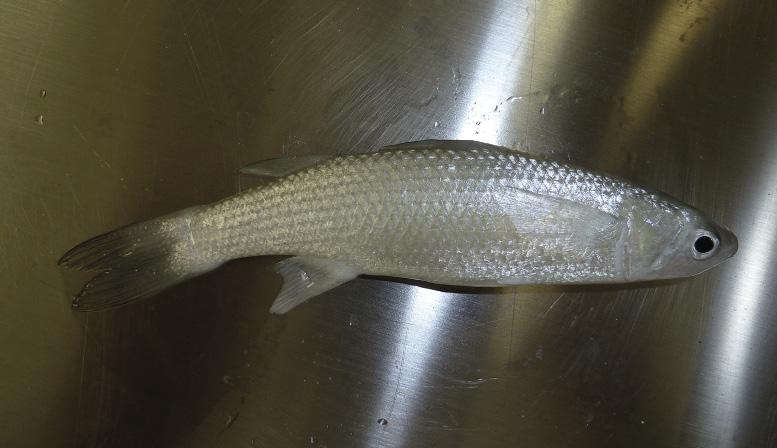
Some pollutants affect the functioning of the animal endocrine system, as they affect hormonal paths. These pollutants are called endocrine disrupting compounds (EDC). Within the EDC group, a large number of chemical substances have been classified that we can find in our daily lives, such as hydrocarbons, detergents, plastic phthalates, pesticides, etc.
The group of compounds of xenoestrogens is the most worrying EDC, since they are able to mimic the hormone, estrogen, most important for reproduction in the vertebrate females. This is the case of synthetic hormones, such as those used in birth control pills, and other chemical compounds, such as bisphenol and phthalate, used in the synthesis of plastics, or nonilphenol present in some detergents and insecticides. All of them are found in the medium and are able to interact with the organisms present, even in low concentrations.
Due to various human activities, all these compounds reach aquatic means. The collection, treatment and cleaning of industrial and domestic wastewater is carried out in the wastewater treatment plants, but the xenoestrogens cannot be completely eliminated from the water, existing a estrogenic activity in the waters that are released from the wastewater treatment plants to the rivers.
Fish may be in permanent contact with these substances. Xenoestrogens are associated with the estrogen receptors present in the cells, affecting the processes that should be subjected to hormonal control and causing changes in the functions that animals perform due to estrogen (development and reproduction). They can have long-term effects. Xenoestrogens affect the mechanisms of fixing and differentiation of fish sex, which can cause an imbalance between the reproductive cycle and a radical change of sex in the most serious cases.
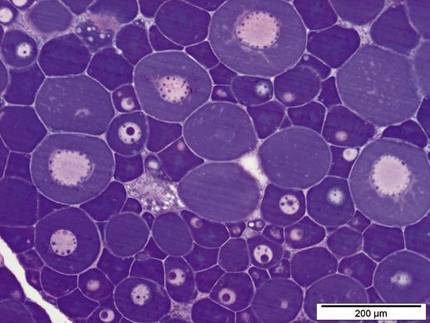
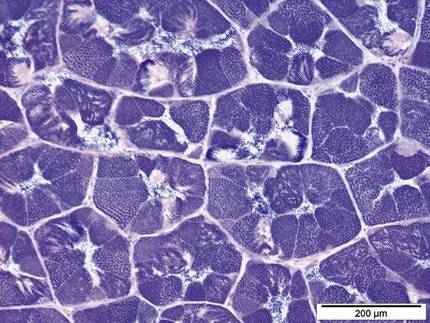
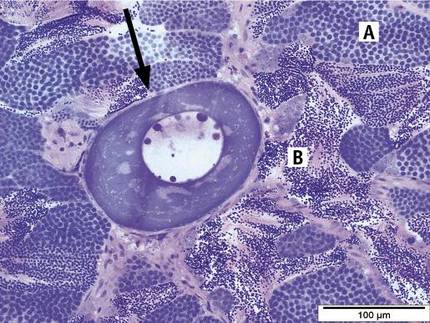
Biomarkers Biomarkers
Analyzing low-level biological organization responses (gene, cell, or textile), early warnings can be obtained about the effects that can occur at higher levels (animal physiology, organism, or population). These analysed responses are called biomarkers and are early indicators of potential effects on long-term health.
To describe the transformations of fish affected by xenoestrogens, biomarkers can be used. The vitelogenin (vtg), produced by the estrogen protein in the liver of the female fish, is transported to the oocytes, precursor of the reserve proteins, the egg vitelo. Xenoestrogenic compounds cause an unusual vtg expression in male and immature fish, which is why it is used as a biomarker of estrogenic compounds.
Another appropriate biomarker of xenoestrogens are aromatases (Cyp19). These enzymes act in the synthesis of steroid hormones, such as estrogens. Responsible for regulating the level of estrogens of vertebrates, they are very important for the determination and differentiation of sex of fish. Exposure to xenoestrogens causes the imbalance of transcription levels of aromatase genes and favors the sexual change of fish.
First, changes occur at the molecular level and then at the tissue level. For example, oocytes have been detected in the testicles of some male fish. They are called “intersex”. This phenomenon has been detected in fish populations around the world in which there is xenoestrogen contamination, which is used as a biomarker at the tissue level.
In recent years, a molecular indicator of the presence and quality of oocytes has been described: 5S rRNA. This molecule is the ribosomal RNA necessary to form the largest subunit of the ribosomes, present in all eukaryotic cells in two ways: in the somatic cells on one side and in the oocytes on the other. It has been observed that the transcription level of 5S rRNA is very high in the fish oocytes that are developing, compared to other ribosomal RNA (18S rRNA…). It is considered necessary to support the initial development of the embryo after a successful fertilization, since thanks to its accumulation the embryo will have the ribosomes necessary for the synthesis of proteins. Therefore, the high transcription of the rRNA 5S of the oocytes allows its use as a marker of sexual change, as an indicator of females. In fish that depend on xenoestrogens, on the contrary, it has become a molecular marker of the status of intersex.
Xenoestrogens in Euskal Herria
In the Basque Country, in 2007, the first xenoestrogenic effects were detected in the population of Chelón labrosus korrokoi that lives around the Gernika treatment plant. The 30% of the males studied were intersexes and although vitelogenin was detected in the blood plasma, it is specifically more feminine. In the bile of the korrokois were found traces of EDC, mainly alkylphenols derived from detergents and paints.
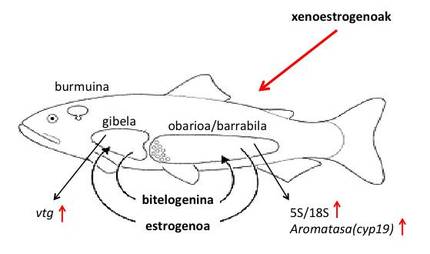
Subsequently, feminized fish have been detected in more areas of the Basque coast: Abran, Ondarroa, Deba and Pasaia, among others. Complex mixtures of contaminants such as lindane, phthalates, alkylphenols, bisphenol A and estrogenic drugs were detected in these fish populations. The EDAR flows are the main sources of emission of these compounds.
To study the origin and evolution of the effects of EDCs that appear on the Basque coast, we have recently analyzed the populations of korrocoas that live below the spills of the Gernika and Galindo treatment plants. During the months of June 2013 and February 2014, fish were captured in both locations and histological and molecular studies were conducted to detect possible indications of processes of intersex and feminization.
In these two populations intersex fish were located, and the levels of Gernika were much higher: despite this, 90% of the intersexes were in the sampling of February. On the contrary, 9% of Galindo's fish were intersex. However, the degree of feminization of galind fish was more serious, since oocytes were abundant in the testicles. In Gernika appeared a few oocytes.
Besides these prevalences, the presence of intersex fish confirms that the water of these purifiers probably escapes to xenoestrogenic compounds. The study of molecular biomarkers allowed to detect high ratios of obocyte marking molecules in intersex fish. Transcription levels of the 5S rRNA and cyp19a1 aromatase genes were similar to those of intersex female fish, reflecting the process of feminizing the testicles. The study of vitelogenin confirmed the results and confirmed the exposure to xenoestrogens in the liver of intersex fish and males, where the expression of the gene of this protein occurs.
Conclusions of the conclusions: Conclusions
Intersex males were detected in the mucosal populations that inhabit around the treatment plants of Gernika and Galindo. In Gernika they found more intersex, but the degree of severity of the intersexes in Galindo was higher, since the number of oocytes in the testicles was higher. Therefore, male fish are becoming females in fish populations in contact with the contaminants emitted by the cleaners.
Future of the future
Although intersex fish are known, it is not clear what are the molecular mechanisms of the phenomenon, at what time of the life cycle intersex fish are converted, what has caused this change... To understand this cellular process well, the first thing to do is to know which genes influence the development of the reproductive system of male and female fish and to measure in which phase of testicular/ovarian development are expressed. In addition, it is advisable to analyze the evolution of gametes. The information obtained allows to design early biomarkers for intersex fish and manage more effectively the risk of presence of xenoestrogens.
References References References References
Note: Note: Note:
This research work was awarded at the IkerGazte Congress the area of Natural Sciences and Sciences. This article is an adaptation for the magazine Elhuyar.

Gai honi buruzko eduki gehiago
Elhuyarrek garatutako teknologia




